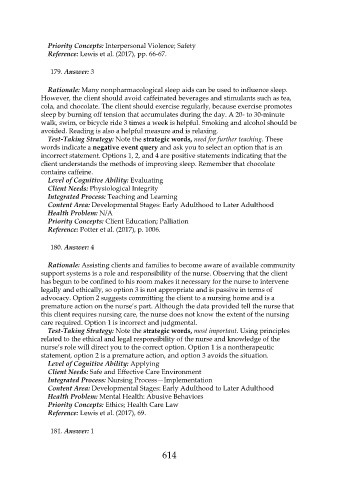Page 614 - Saunders Comprehensive Review For NCLEX-RN
P. 614
Priority Concepts: Interpersonal Violence; Safety
Reference: Lewis et al. (2017), pp. 66-67.
179. Answer: 3
Rationale: Many nonpharmacological sleep aids can be used to influence sleep.
However, the client should avoid caffeinated beverages and stimulants such as tea,
cola, and chocolate. The client should exercise regularly, because exercise promotes
sleep by burning off tension that accumulates during the day. A 20- to 30-minute
walk, swim, or bicycle ride 3 times a week is helpful. Smoking and alcohol should be
avoided. Reading is also a helpful measure and is relaxing.
Test-Taking Strategy: Note the strategic words, need for further teaching. These
words indicate a negative event query and ask you to select an option that is an
incorrect statement. Options 1, 2, and 4 are positive statements indicating that the
client understands the methods of improving sleep. Remember that chocolate
contains caffeine.
Level of Cognitive Ability: Evaluating
Client Needs: Physiological Integrity
Integrated Process: Teaching and Learning
Content Area: Developmental Stages: Early Adulthood to Later Adulthood
Health Problem: N/A
Priority Concepts: Client Education; Palliation
Reference: Potter et al. (2017), p. 1006.
180. Answer: 4
Rationale: Assisting clients and families to become aware of available community
support systems is a role and responsibility of the nurse. Observing that the client
has begun to be confined to his room makes it necessary for the nurse to intervene
legally and ethically, so option 3 is not appropriate and is passive in terms of
advocacy. Option 2 suggests committing the client to a nursing home and is a
premature action on the nurse’s part. Although the data provided tell the nurse that
this client requires nursing care, the nurse does not know the extent of the nursing
care required. Option 1 is incorrect and judgmental.
Test-Taking Strategy: Note the strategic words, most important. Using principles
related to the ethical and legal responsibility of the nurse and knowledge of the
nurse’s role will direct you to the correct option. Option 1 is a nontherapeutic
statement, option 2 is a premature action, and option 3 avoids the situation.
Level of Cognitive Ability: Applying
Client Needs: Safe and Effective Care Environment
Integrated Process: Nursing Process—Implementation
Content Area: Developmental Stages: Early Adulthood to Later Adulthood
Health Problem: Mental Health: Abusive Behaviors
Priority Concepts: Ethics; Health Care Law
Reference: Lewis et al. (2017), 69.
181. Answer: 1
614

